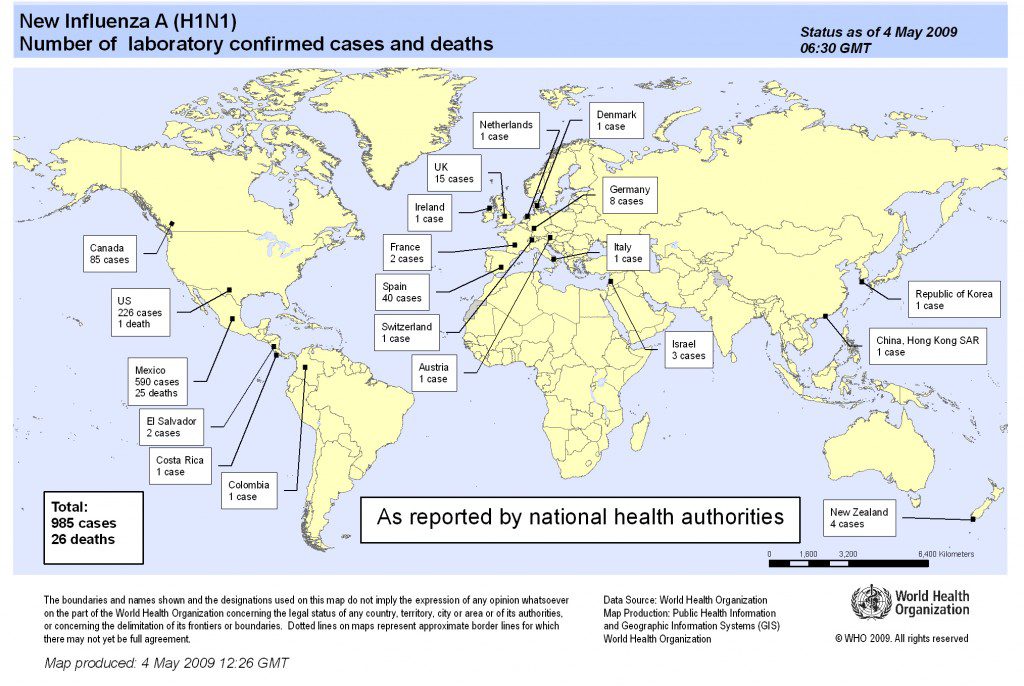

There have been laboratory confirmed cases of infection in over half of the United States (30), with a total of 226 cases and the one death in Texas last week. Globally, 20 countries have reported 985 cases of infection. The highest numbers are in Mexico, with 590 cases and 25 deaths.
According to CDC, very few of the American cases are in individuals who are over 50 years of age. This observation suggests that exposure to previous H1N1 strains might confer some protection against infection, as suggested by Dr. Peter Palese. Individuals who are over 50 today were born in 1959 or earlier. Recall that from 1918 to 1957, H1N1 influenza viruses circulated globally. Those who are older than 50 were likely to have been infected with H1N1 influenza virus strains during those years. Whether or not there is any protection from such previous exposure will likely be determined by laboratory tests in the near future.
Also very interesting is the report from Alberta, Canada that pigs have been infected with the human H1N1 virus. It is believed that the animals were exposed to the virus by a Canadian who had returned from Mexico with flu-like symptoms. This report raises more questions than it answers. But if the new H1N1 virus can readily infect pigs, this could serve as a new source of the virus for future outbreaks. Promedmail poses the tough but important questions:
First, how was directionality of infection established? Was the worker sick when he came in contact with pigs? If so, what lapse in biosecurity allowed a sick human worker to even be on a swine farm as standard biosecurity practices on progressive or up to date swine farms would screen such an individual out and prevent him or her from coming into contact with pigs? Has the worker tested positive for the novel influenza A H1N1 virus? What is the prevalence of the new virus in the swine herd and finally, but most importantly, what quarantine and traceback procedures are in place to make sure that the swine herd does not infect other swine farms? Finally, although we know animal diagnostic laboratories have never seen this virus before in pigs, what surveillance efforts are being made to look at previous swine serum banks or test apparently healthy swine herds on a population basis to actively ensure swine populations are free of this novel influenza A H1N1 virus?
Another important question concerns influenza vaccines. According to Health and Human Services Secretary Kathleen Sebelius, vaccines for the new strains, as well as last season’s, will be ready this fall. Clearly we need a vaccine containing the new H1N1 strain and the relevant influenza B virus strain. But what about last season’s strains – there were two, an H1N1 and an H3N2. If these were also included, that would make for a tetravalent influenza virus vaccine.
Here is one bit of information which would argue against including last year’s H3N2 and H1N1 strains in this fall’s vaccine. In each previous pandemic, the newly emerging viruses replaced the previous circulating strain. For example, in 1968, the H3N2 virus replaced H2N2 viruses that had been causing influenza since 1957. Whether or not the new H1N1 viruses replace the two previous strains will be an important question to address in the coming months. Such information will be used to make decision about the components of the influenza virus vaccine used this fall.
Update: terrific map from WHO on laboratory confirmed cases.


What do you make of this? I thought it was unlikely to hit the GI tract.
“For disease investigators at the W.H.O., there are still more questions than answers about the new flu strain, Dr. Fukuda said. The organization has determined that the cases of the virus have ranged from very mild to fatal, and that the disease is resulting in diarrhea in 40 to 50 percent of cases, more than in regular flu. The incubation period also may be longer than for regular flu, up to 6-8 days, Dr. Fukuda said.”.
http://www.nytimes.com/2009/05/05/health/05flu….
Interesting observation. I doubt very much that the virus is infecting
the GI tract. Rather, the GI symptoms are either a consequence of
co-infection with another pathogen (e.g. norovirus) or the immune
system response to influenza virus infection. As for incubation
period, it can range from 24 hours to 4-5 days, depending upon dose of
virus and immune status of the host.
If it hasn't been commented on yet:
I wonder why the CDC chose to deposit the Mexico sequences at the GSAID instead of the much more useful NCBI?
http://platform.gisaid.org
And why have the GSAID chosen to 'protect' the sequences by requiring approved registration/login accounts?
I notice that WHO are acting like cornered lawyers and only counting cases which are confirmed by their tests in their own laboratories.
Here in New Zealand we currently have six confirmed cases, 69 suspected, down 20 from the day before, and 335 in isolation, down by 25.
I've been unable to find anything about the test WHO are using. How specific is it ? What are it's false positive and false negative rates? What level of infection at time of sample are required to get a positive result?
How did they come up with a test, in which they place such faith, in a matter of days since the identification of the pathogen ?
I just noticed today that the sequences are in GSAID. Don't know the
reason why they are there as opposed to NCBI. GSAID has always
required registration/login. Proprietary reasons?
Not directly in regards to the current 'outbreak', but why does the normal flu vaccine only contain 3 strains? Wouldn't we be more likely to include the right strains if the vaccine had 4 or 5 different strains in it?
From CDC: Recomended test is 1) qPCR, 2) Viral culture
http://www.cdc.gov/h1n1flu/recommendations.htm
From WHO: same tests at designated labs in approved countries
http://www.who.int/csr/disease/swineflu/WHO_cas…
Read that China is working on and will deliver improved PCR based assays.
try to see http://www.emedicaltips.com
Is that your site? It would be gracious of you, when copying entire
posts from my virology blog, if you would at least give attribution.
That means a link back to the original content. Thank you.
Question – if the current swine flu contains genetic material from three sources – swine, avian and human, is there a possibility that infection with this milder version (Upper respiratory illness vs. lower respiratory illness in avian flu) could confer immunity to avian flu and hence abate a nastier illness? ie. could this cloud have a silver lining?
I noticed that in California most cases are piled at the border (see stats by county here http://ww2.cdph.ca.gov/Pages/default.aspx). I am wondering about your interpretation and the possible implications. Does it suggest the obvious that citizens here likely recently crossed the border to Mexico and it has been well relatively well contained after traveling back (i.e. no travel to Northern California etc. where documented cases are low)? Or are there be other interpretations you can think of? Implications? In any case, I think the stats are interesting, wanted to share.
According to CDC, very few of the American cases are in individuals who are over 50 years of age. This observation suggests that exposure to previous H1N1 strains might confer some protection against infection
I don't see how that follows in the slightest. The vast majority of spread in the US has been via schools, meaning that the majority of victims will be (a) schoolchildren and (b) their parents. It does not take a rocket scientist to work out why these two categories of people are under 50 years of age!
I think this may be a consequence of the way influenza vaccines are currently produced. It is egg-based, which means we need one egg for each flu strain and every vaccine. With 3 different strains, that's three eggs per vaccine. I imagine the logistics get very difficult very quickly beyond 3 strains.
This may not be the best place to post this, but I find no other mention of it.
There was an interesting ProMed-mail post today:
http://www.promedmail.org/pls/otn/f?p=2400:1001…
Basically, the author, from the British Columbia Centre for Disease Control, says that while testing for H1N1, a lot of new cases of H3N2 were found, and that the H3N2 strain had changed. The author speculated that some of the late season Mexico flu reports could have actually been due to the new H3N2 variant.
One Mexican sequence has now been deposited at NCBI.
Older people work in schools. And this has not been the only location
of the cases.
Cool. Good to know. Thanks. There is a little bit of seq drift but probably essentially the same.
Really enjoy your web site. Learning lots. Thank you.
BTW, did finally get my account this afternoon. I did complain directly. Interesting email exchange:>)They are hyper worried about the whole IP thing, kind of anti industry, but I understand.
Keep up the good work!
Best regards John Marken
This may not be the best place to post this, but I find no other mention of it.
There was an interesting ProMed-mail post today:
http://www.promedmail.org/pls/otn/f?p=2400:1001…
Basically, the author, from the British Columbia Centre for Disease Control, says that while testing for H1N1, a lot of new cases of H3N2 were found, and that the H3N2 strain had changed. The author speculated that some of the late season Mexico flu reports could have actually been due to the new H3N2 variant.
One Mexican sequence has now been deposited at NCBI.
Older people work in schools. And this has not been the only location
of the cases.
Cool. Good to know. Thanks. There is a little bit of seq drift but probably essentially the same.
Really enjoy your web site. Learning lots. Thank you.
BTW, did finally get my account this afternoon. I did complain directly. Interesting email exchange:>)They are hyper worried about the whole IP thing, kind of anti industry, but I understand.
Keep up the good work!
Best regards John Marken
Pingback: Influenza A/Mexico/2009 (H1N1) - Questions and answers